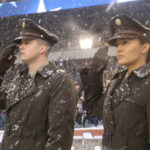The world of sports has long embraced the charm of the past, with teams frequently donning “throwback” uniforms that resonate with fans and celebrate franchise history. Now, the US Army is taking a leaf out of this book, finalizing its decision to reinstate a throwback uniform reminiscent of the WWII era – the distinguished officer uniform affectionately known as “pinks and greens.” This move is not just a nostalgic nod to the past but a strategic decision aimed at rekindling a sense of pride and connection to a pivotal period in American history.
During World War II, the officer uniform was a symbol of distinction and competence. The winter service uniform, in particular, was crafted from a dark olive-drab gabardine wool coat (the greens) paired with lighter shade drab trousers (the pinks), creating a subtle yet noticeable contrast. Completing the ensemble were Army russet brown service caps and shoes. This attire sharply contrasted with the uniforms of enlisted personnel, who wore a less elaborate uniform in a medium olive-drab shade for both trousers and service coats. This visual differentiation underscored the leadership roles and responsibilities held by officers.
Image: A close-up view of a WWII US Army officer’s “pinks and greens” uniform showcasing the color contrast and fabric texture.
The modern revival of the pinks and greens uniform is set to be available across all ranks, serving a similar purpose to the dress green uniform that was retired in 2015. Interestingly, the current dress-blue uniform will transition to an optional formal wear, highlighting the significance of the returning WWII-inspired uniform. Prototypes suggest a close resemblance to the original WWII design, incorporating nuances that were prevalent during that era. One such detail is the “crusher cap,” initially a modification by flight crews who removed the stiffener from their service caps to accommodate headphones. This practical adjustment led to a distinctive “crushed” look, quickly becoming a sought-after symbol of status among aircrews, as recognizable as their flight wings and leather jackets. The prototype service cap suggests a continuation of this iconic “crusher” styling.
Further expanding the throwback concept, the Army is reportedly considering the introduction of a WWII-style leather flight jacket and the shorter “Ike” service jacket as optional uniform items. Sergeant Major of the Army Daniel Dailey articulates that the adoption of this uniform is a deliberate effort to remind contemporary America of a time when public esteem for the Army was exceptionally high. This initiative taps into the powerful symbolism of the WWII generation and their monumental achievements.
Image: A group of US Army officers in “pinks and greens” uniforms during World War II, illustrating the uniform in its historical context.
This strategic return to a classic uniform resonates with the enduring appeal of historical military attire. The US Marine Corps, for example, has maintained the essence of its WWII service uniforms with minimal alterations, arguably contributing to a strong and consistent brand identity. By August 1945, the US Army had grown to over eight million soldiers, having triumphed in some of history’s most significant and brutal campaigns. The question then arises: why deviate from a uniform so deeply associated with such a victorious period? It’s akin to questioning a change to the New York Yankees’ iconic pinstripes – some traditions are powerfully linked to identity and success.
However, history reveals that the shift away from the WWII olive-drab “Class A” uniform to the dress green service uniform in 1954 was driven by practical reasons. A post-war surplus of WWII uniforms led to their widespread use as cheap workwear, even in prisons. The adoption of the dress green uniform was, in part, an effort to restore a sense of distinction and pride within the ranks of the post-WWII Army, moving away from the over-familiarity and reduced prestige of the surplus uniforms.
Now, seventy-five years after the end of World War II, the context has changed dramatically. The days of WWII uniforms being repurposed as everyday clothing are long gone. The decision by Sergeant Major of the Army Dailey and Chief of Staff General Mark Milley to bring back the classic “pinks and greens” officer uniform is a commendable step. It’s a revival that not only honors the legacy of the WWII generation but also aims to reconnect today’s Army with a powerful symbol of American strength and historical pride.

